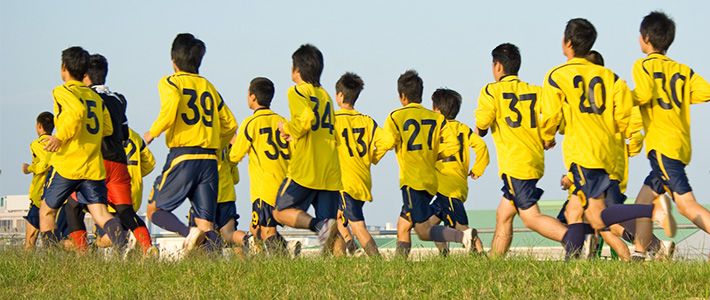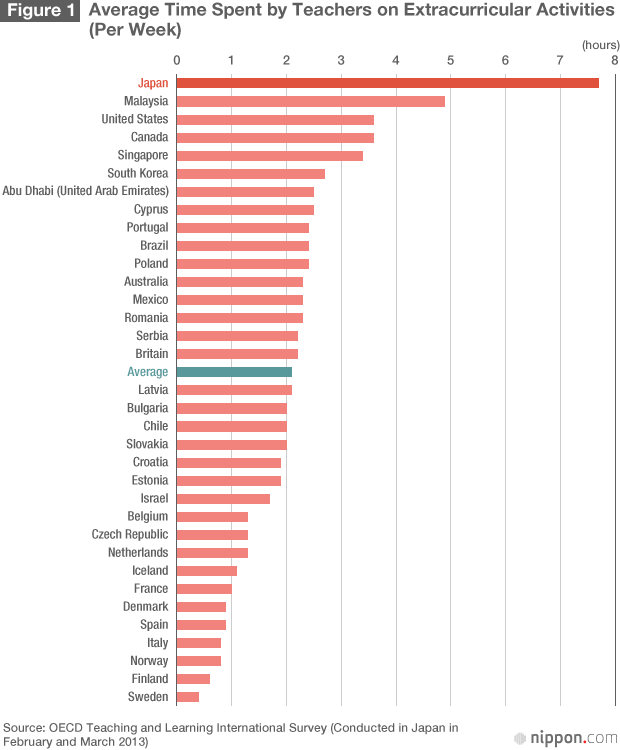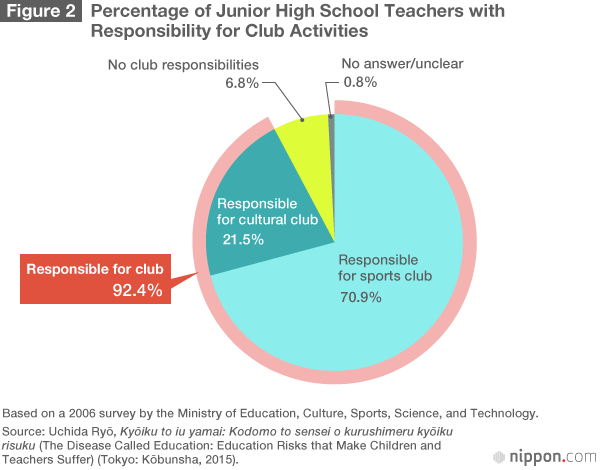
“Voluntary” After-School Duties Mean Japanese Teachers Are Busiest in the World
Society- English
- 日本語
- 简体字
- 繁體字
- Français
- Español
- العربية
- Русский
The Longest Working Hours in the World
Japan’s teachers are overworked. They toil away at school from early morning until late at night, and many go in on weekends too, preventing them from getting a proper rest before Monday comes round again.
In the 2013 Teaching and Learning International Survey, conducted in 34 countries and regions by the Organization for Economic Cooperation and Development, researchers found that Japanese teachers had the longest working hours.
This was not due to the amount of time spent teaching. In fact, class time in Japan was below the survey average. The long hours result from various other duties, including meetings and lesson preparation. Most striking of all is how much longer teachers in Japan dedicate to extracurricular activities, as shown in figure 1.

Cultivating Enjoyment of Sports and Culture
In Japanese junior high and high schools, club activities may take place in the morning before classes, after school, or on weekends. Teachers put many extracurricular hours into instructing students in sporting and cultural pursuits.
Government guidelines concerning education in secondary schools state that the aims of club activities are to cultivate enjoyment of sports, culture, science, and other areas; to contribute to increased desire to study; and to foster responsibility and solidarity. Owing to their public nature, schools offer these activities to students at little cost. Said another way, the purpose of extracurricular activities is to ensure that students have an inexpensive way to enjoy sports or culture during nonclass hours.
School-Centered Sports
From a global perspective, it is unusual for schools to involve themselves so fully in activities for students outside of class. The results for an international survey on where extracurricular sports activities are held, shown in the table below, indicate that while schools are the principal venues in Japan and some other Asian countries, community clubs frequently host these activities in other parts of the world.
Location for Extracurricular Junior High and High School Sports Activities Around the World
| Mainly at School | At School and in the Community | Mainly in the Community | |
|---|---|---|---|
| Japan China South Korea Taiwan Philippines | Canada United States Brazil Scotland England Netherlands Belgium France Spain Portugal | Poland Soviet Union (now Russia) Israel Egypt Nigeria Kenya Botswana Malaysia Australia New Zealand | Norway Sweden Finland Denmark Germany Switzerland Zaire (now Democratic Republic of the Congo) Yemen Thailand |
Source: Nakazawa Atsushi, “Undō bukatsudō wa Nihon dokutoku no bunka de aru: Shogaikoku to no hikaku kara” (Sports Club Activities Are Unique to Japan: Comparisons With Other Countries), Synodos, January 27, 2015, http://synodos.jp/education/12417.
In fact, the extensiveness of school-organized sports activities are particular to Japan, even when compared to other Asian countries. Nakazawa Atsushi, the Waseda University associate professor who conducted the above survey and is an expert on the subject, says that Japan is unique in the predominance and scale of school clubs when it comes to youth sports.(*1)
Voluntary for Neither Students Nor Teachers
Government guidelines say that student participation in club activities is voluntary. Some schools, though, make it a requirement for all students to join some club.
Even at schools without such a requirement, most junior high and high school students belong to a club anyway. A 2009 survey by Benesse Educational Research and Development Institute found that 90% of students in secondary education take part (or previously took part) in club activities.
In theory, club activities are voluntary for teachers as well as students, as they are not part of the curriculum. Teachers are ostensibly under no obligation to serve as club advisors and do so entirely of their own volition.
It is customary, though, for all teachers—particularly at junior high schools—to be involved. The data is somewhat old, but a 2006 survey by the ministry of education found that 92.4% of junior high school teachers had responsibility for club activities, as shown in figure 2.

Workers Before Educators
Because club activities are “voluntary,” teachers get no overtime pay on weekdays, no matter how late they remain in school. Even on weekends, they often receive only a token payment of just a few thousand yen. Students are thus ensured an inexpensive way to enjoy sports or culture during nonclass hours thanks to the unpaid labor of the teaching staff.
With almost all instructors being pressured to oversee club activities without remuneration, the issue of their long hours has broader implications.
Teachers have rights just like workers in other occupations. Redressing the burden of extracurricular activities would help guarantee their fundamental rights and allow them to properly interact with students as educators. New ideas and measures are needed to alleviate the long hours of Japanese teachers.(*1) ^ Undō bukatsudō no sengo to genzai (Club Activities in the Postwar Era and Today) (Tokyo: Seikyūsha, 2014), 47.